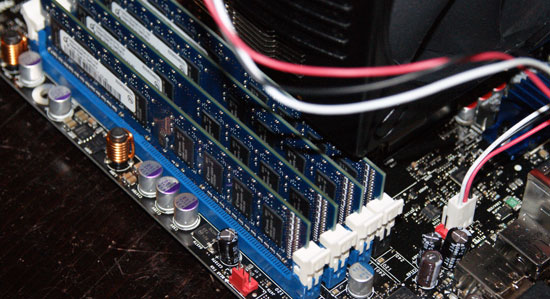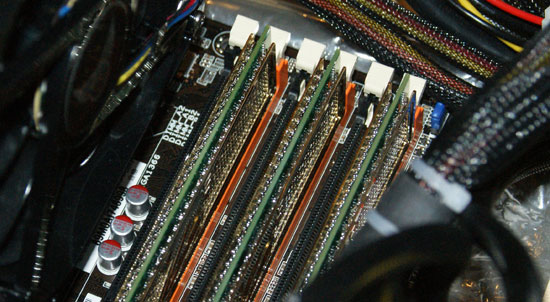The Dark Knight: Intel's Core i7
by Anand Lal Shimpi & Gary Key on November 3, 2008 12:00 AM EST- Posted in
- CPUs
Understanding Nehalem's Memory Architecture
Nehalem does spice things up a bit in the memory department, not only does it have an integrated memory controller (a first for an x86 Intel CPU) but the memory controller in question has an unusual three-channel configuration. All other AMD and Intel systems use dual channel DDR2 or DDR3 memory controllers; with each channel being 64-bits wide, you have to install memory in pairs for peak performance.
With a three-channel DDR3 memory controller, Nehalem requires the use of three DDR3 modules to achieve peak bandwidth - which also means that the memory manufacturers are going to be selling special 3-channel DDR3 kits made specifically for Nehalem. Motherboard makers will be doing one of two things to implement Nehalem's three-channel memory interface on boards; you'll either see boards with four DIMM slots or boards with six:

Four DDR3 slots, three DDR3 channels
In the four-slot configuration the first three slots correspond to the first three channels, the fourth slot is simply sharing one of the memory channels. The downside to this approach is that your memory bandwidth drops to single-channel performance as you start filling up your memory. For example, if you have 4 x 1GB sticks, the first 3GB of memory will be interleaved between the three memory channels and you'll get 25.6GB/s of bandwidth to data stored in the first 3GB. The final 1GB however won't be interleaved and you'll only get 8.5GB/s of bandwidth to it. Despite the unbalanced nature of memory bandwidth in this case, your aggregate bandwidth is still greater in this configuration than a dual-channel setup.

Six DDR3 slots, two slots per DDR3 channel
The more common arrangement will be six DIMM slots where each DDR3 channel is connected to a pair of DIMM slots. In this configuration as long as you install DIMMs in triplicate you'll always get the full 25.6GB/s of memory bandwidth.
That discussion is entirely theoretical however, the real question is: does Nehalem's triple-channel memory controller actually matter or would two channels suffice? I suspect that Hyper Threading simply improved Nehalem's efficiency not necessarily its need for more data. The three-channel memory controller is probably far more important for servers and will be especially useful in the upcoming 8-core version of Nehalem due out sometime next year. To find out we simply benchmarked Nehalem in a handful of applications with a 4GB/dual channel configuration and a 6GB/triple-channel configuration. Note that none of these tests actually used more than 4GB of memory so the size difference doesn't matter, we kept memory timings the same between all tests.
| Dual Channel DDR3-1066 (9-9-9-20) | Triple Channel DDR3-1066 (9-9-9-20) | |
| Memory Tests - Everest v1547 | ||
| Read Bandwidth | 12859 MB/s | 13423 MB/s |
| Write Bandwidth | 12410 MB/s | 12401 MB/s |
| Copy Bandwidth | 16474 MB/s | 18074 MB/s |
| Latency | 37.2 ns | 44.2 ns |
| Cinebench R10 (Multi-threaded test) | 18499 | 18458 |
| x264 HD Encoding Test (First Pass / Second Pass) | 83.8 fps / 30.3 fps | 85.3 fps / 30.3 fps |
| WinRAR 3.80 - 602MB Folder | 118 seconds | 117 seconds |
| PCMark Vantage | 7438 | 7490 |
| Vantage - Memories | 6753 | 6712 |
| Vantage - TV and Movies | 5601 | 5637 |
| Vantage - Gaming | 10202 | 9849 |
| Vantage - Music | 5378 | 4593 |
| Vantage - Communications | 6671 | 6422 |
| Vantage - Productivity | 7589 | 7676 |
| WinRAR (Built in Benchmark) | 3283 | 3306 |
| Nero Recode - Office Space - 7.55GB | 131 seconds | 130 seconds |
| SuperPI - 32M (mins:seconds) | 11:55 | 11:52 |
| Far Cry 2 - Ranch Medium (1680 x 1050) | 62.1 fps | 62.4 fps |
| Age of Conan - 1680 x 1050 | 51.5 fps | 51.1 fps |
| Company of Heroes - 1680 x 1050 | 136.6 fps | 133.6 fps |
At DDR3-1066 speeds we found no real performance difference between the Core i7-965 running in two channel vs. three channel mode, the added bandwidth is simply not useful for most desktop applications. For some reason we were able to get better latency scores on the dual-channel configuration, but there's a good chance that may be due to the early nature of BIOSes on these boards. In benchmarks were the latency difference was noticeable we saw the dual-channel configuration pull ahead slightly, then in other tests where the added bandwidth helped we saw the triple-channel configuration do better. Honestly, it's mostly a wash between the two.
Our recommendation would be to stick with three channels, but if you have existing memory and can't populate the third channel yet it's not a huge deal, really, two is fine here for the time being.










73 Comments
View All Comments
Spectator - Monday, November 3, 2008 - link
that sht is totally logical.And Im proper impressed. I would do that.
you can re-process your entire stock at whim to satisfy the current market. that sht deserves some praise, even more so when die shrinks happen. Its an apparently seemless transition. Unless world works it out and learns how to mod existing chips?
Chukkle. but hey im drunk; and I dont care. I just thought that would be a logical step. Im still waiting for cheap SSD's :P
Spectator.
tential - Monday, November 3, 2008 - link
We already knew nehalem wasn't going to be that much of a game changer. The blog posts you guys had up weeks ago said that because of the cache sizes and stuff not to expect huge gains in performance of games if any. However because of hyperthreading I think there also needs to be some tests to see how multi tasking goes. No doubt those gains will be huge. Virus scanning while playing games and other things should have extremely nice benefits you would think. Those tests would be most interesting although when I buy my PC nehalem will be mainstream.npp - Monday, November 3, 2008 - link
I'm very curious to see some scientific results from the new CPUs, MATLAB and Mathematica benchmarks, and maybe some more. It's interesting to see if Core i7 can deliver something on these fronts, too.pervisanathema - Monday, November 3, 2008 - link
I was afraid Nehalem was going to be a game changer. My wallet is grateful that its overall performance gains do not even come close to justifying dumping my entire platform. My x3350 @ 3.6GHz will be just fine for quite some time yet. :)Additionally, its relatively high price means that AMD can still be competitive in the budget to low mid range market which is good for my wallet as well. Intel needs competition.
iwodo - Monday, November 3, 2008 - link
Since there are virtually no performance lost when using Dual Channel. Hopefully we will see some high performance DDR3 with low Latency next year?And which means apart from having half the core, Desktop version doesn't look so bad.
And since you state the Socket 1366 will be able to sit a Eight Core inside, i expect the 11xx socket will be able to suit a Quad Core as well?
So why we dont just have 13xx Socket to fit it all? Is the cost really that high?
QChronoD - Monday, November 3, 2008 - link
How long are they going to utilize this new socket??$284 for the i7-920 isn't bad, but will it be worth the extra to buy a top end board that will appreciate a CPU upgrade 1-2 years later? Or is this going to be useless once Intel Ticks in '10?
Strid - Monday, November 3, 2008 - link
Great article. I enjoyed reading it. One thing I stumbled upon though."The PS/2 keyboard port is a nod to the overclocking crowd as is the clear CMOS switch."
What makes a PS/2 port good for overclockers? I see the use for the clear CMOS switch, but ...
3DoubleD - Monday, November 3, 2008 - link
In my experience USB keyboards do not consistently allow input during the POST screen. If you are overclocking and want to enter the BIOS or cancel an overclock you need a keyboard that works immediately once the POST screen appears. I've been caught with only a USB keyboard and I got stuck with a bad overclock and had to reset the CMOS to gain control back because I couldn't cancel the overclock.Clauzii - Monday, November 3, 2008 - link
I thought the "USB Legacy support" mode was for exactly that? So legacy mode is for when the PC are booted in DOS, but not during pre?sprockkets - Monday, November 3, 2008 - link
No, USB legacy support is for support during boot up and for the time you need input before an OS takes control of the system. However, as already mentioned, sometimes USB keyboards just don't work in a BIOS at startup for one reason or another, and in my opinion, this means they should NEVER get rid of the old PS/2 port.I ran into this problem with a Shuttle XPC with the G33 chipset, which had no ps/2 ports on it. There was a 50/50 chance it would not work.